Contrast factor of a stack of F-P etalons and blocking filter
Center Wave Length (CWL)
and bandpass (FWHM) as a function of f-ratio of the telescope and
tilt of the F-P filter (in collimated beam, telecentric beam or
non-optimized telecentric system)
CWL shift and FWHM broadening in non telecentric systems (refractors and Cassegrain telescopes) and useful formulae
Daystar filter modelling and additional results
Air-spaced F-P etalon theoritical performances and comparison with mica-spaced etalons
Tilted air-spaced etalons in telecentric beam or in a f/115 convergent beam
Analysis of the PST modification (air-spaced F-P etalon) and comparison between collimated and telecentric mounts
Contrast factor of the F-P etalon and blocking filter assembly
Contrast factor of the F-P etalon : test of various stacking schemes
Fabry-Perot math and bibliography
Selectivity of a filter combination
The following figure compares the intensity of the solar spectrum and the transmission profile of a 0.6 A FWHM F-P etalon :
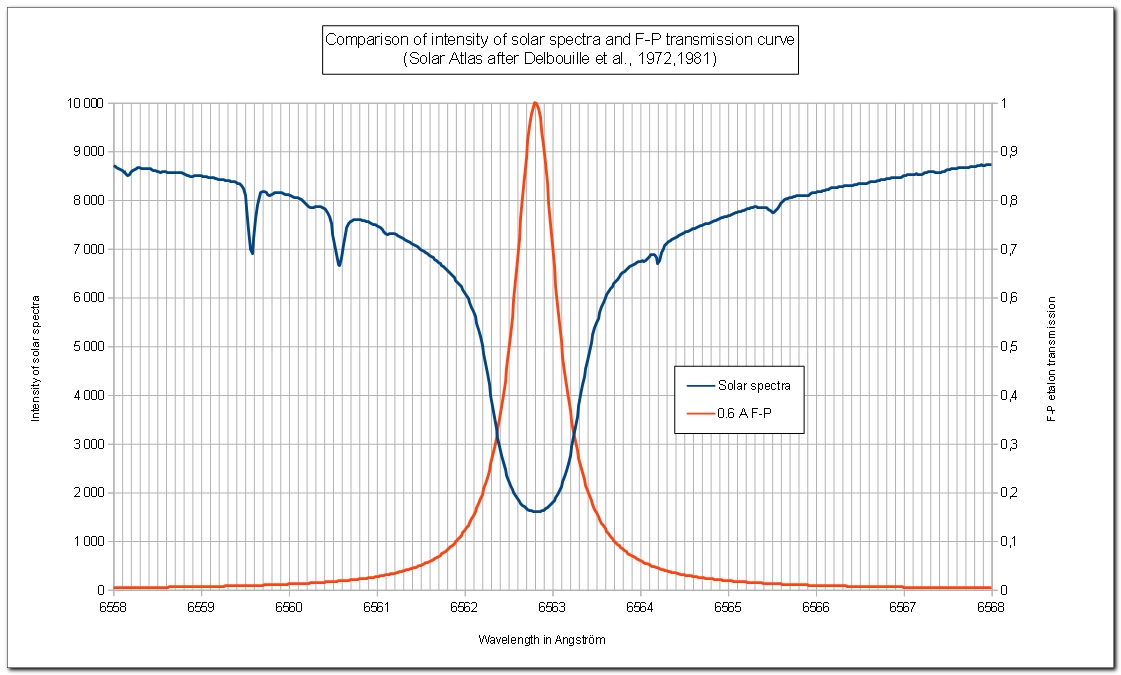
The width of the Ha absorption line is about 1 A at
4000 normalized intensity, 0.8 A at 3000 intensity and 0.55 A at 2000
intensity.
The role of the Ha filter is to block the unwanted light
of the photosphere, in other words the light outside this absorption
line (strickly speaking there is still some amount of photosphere light
even in the Ha line ...).
We already know that some amount of light is
transmitted by the F-P etalon outside its own FWHM. A more interesting
question is how much light is transmitted by the filter outside the Ha
line ? The ideal filter combination would block everything out of the Ha line.
Based on the solar spectra detailed profile (BASS2000)
and on the transmission profile of the filter combination, we can
calculated :
- The amount of light transmitted by the filter combination inside the Ha line. This is the "on-band light".
- The amount of light transmitted by the filter combination outside the Ha line. This is the unwanted "off-band light".
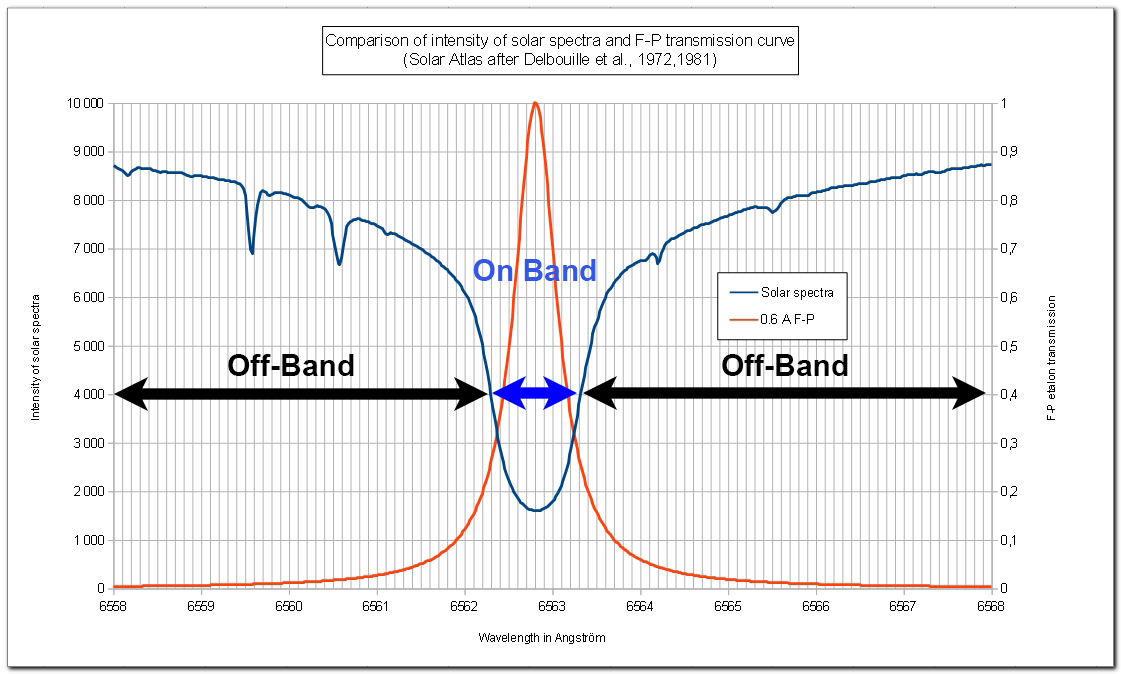
The above figure illustrates the case which a 1 A window, meaning that the 1 A window
centered on Ha is declared "on-band", while the outside of this band is
declared "off-band".
However, the results presented hereafter are made
with a 0.8 A window (this does not change very significantly the
ranking between filters, but makes easier the discrimitation
between double-stack combinations).
Let's call "selectivity" of the filter the following ratio:
selectivity = on-band light / (total light transmitted by the filter)
This ratio is a very good indicator of the blocking
capacity of the filter, and its ability to cut the unwanted
photospheric light outside the Ha line.
- Selectivity is equal to 100% when the filter transmits
the light from inside the Ha line, but no light outside Ha (square
transmission profile centered on Ha).
- If slectivity is equal to 50%, it means that the light coming
from inside the Ha line accounts for half of the total amount of light
transmitted by the filter.
Modelling of the blocking filter (BF):
In order to calculate the selectivity of a filter
stack, we need to take into account the Blocking Filter (BF). Indeed, a
F-P etalon is not used alone but associated with a
blocking filter whose role is to cut the unwanted
interference
orders of the F-P etalon.
Three different blocking filters are considered:
a) Andover 10 A 2-cavity
filter (ref 656FS02). This is the filter used by DayStar. The
profile used is the one of the "unblocked" version (data
from Andover provided at 0.2 A resolution (txt file).
The CWL is 6563 A (+2 A/-0) and peak transmission of 72%.
By comparison, the "blocked" version has a peak transmission of 45%
(Andover data).
For the calculations, the transmission profile is shifted in order to center the CWL on Ha.
b) SolarSpectrum uses a 3-cavity 10 A filter. Its
profile is approximated by the profile of Alluxa 656.3-1_OD4_7018
at 0.4 A resolution.
c) Coronado BF
The measurements of the FWHM of the BF associated
to Coronado air-spaced etalons lie in the range of 6.5 A to 7.8 A
(sources: K.M. Harrison, Bazin & Koutchmy, P. Höbel, C.
Viladrich)
The data actually used is the calculations is the one made by Christian Viladrich (FWHM = 6.9 A). The raw transmission profile is shifted in order to center the CWL on Ha.
Transmission profiles of a 1.0 A mica-spaced etalon, Andover 10 A BF
2-cavity blocking filter and Alluxa 10 A 3-cavity blocking filter:
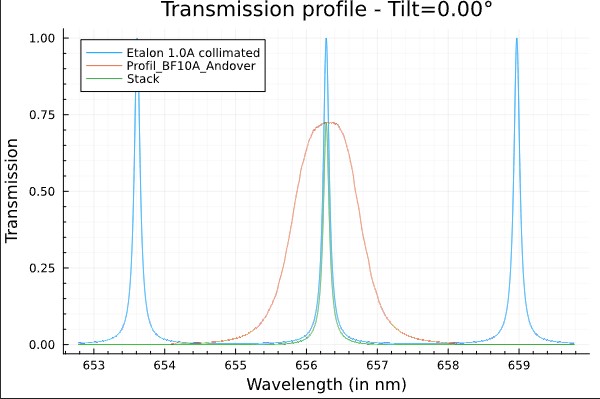

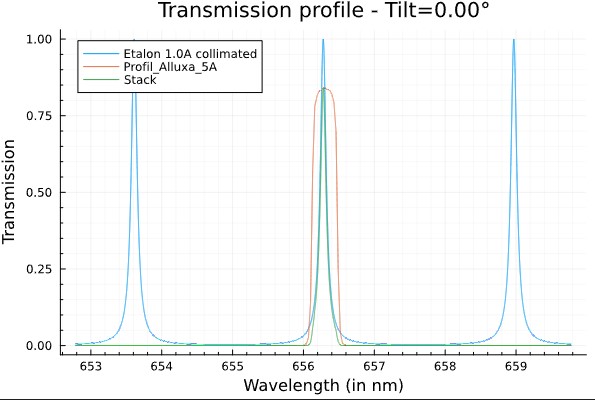
Transmission profiles of a 0.7 A air-spaced etalon, Coronado BF
(6.9 A) and Alluxa 10 A 3-cavity blocking filter:
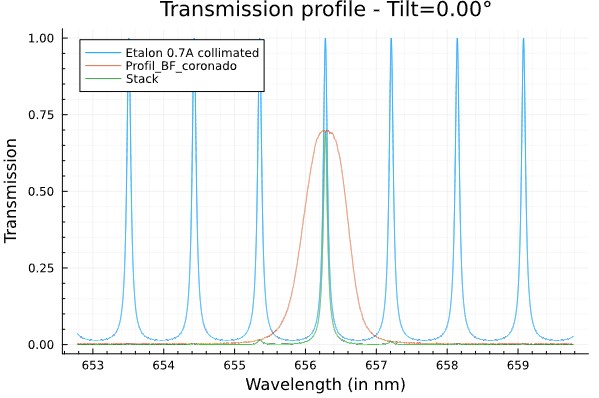
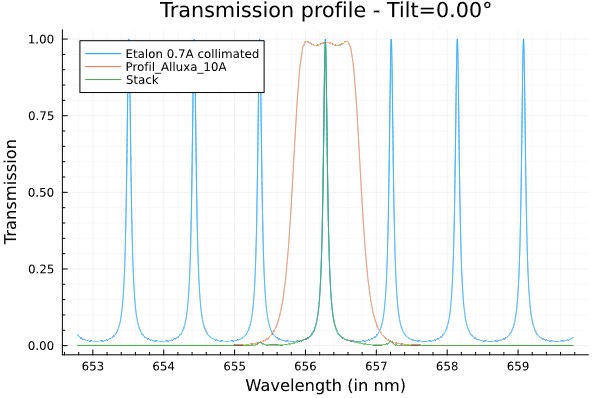
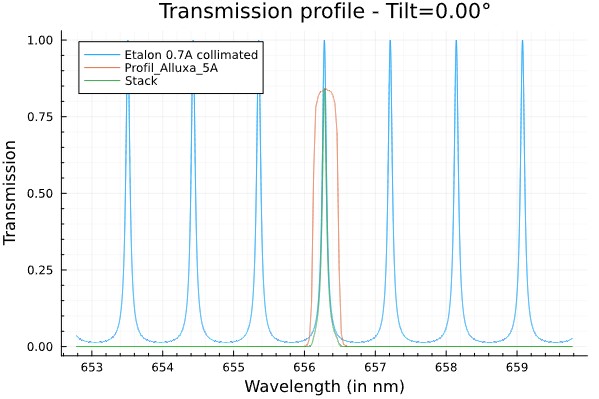
Surprising as it may be, Alluxa 10 A and Coronado BF have quite
similar off-band blockage in spite of the larger FWHM of the Alluxa.
This is because of the higher peak transmission and steeper
transmission profile (3-cavity instead of 2-cavity) of the Alluxa.
Ha selectivity of various filter stacks in collimated beam
The following table presents the Ha selectivity of
various filter combinations, based on the previous data.
Unless otherwise mentionned, etalons are mica-spaced.

Comments
- With a single stack 0.7 A mica-spaced etalon, only 30% of the
light transmited by the filter (etalon+BF) comes from the chromosphere.
- Comparison of single-stack and double-stack:
- The selectivity of a double-stack 1.3
A air-spaced etalon is similar to the selectivity of a 0.55 A etalon,
while having a larger FWM (0.85 A instead of 0.55 A).
- The selectivity of a double-stack 0.7 A air-spaced etalon is much
larger than a single-stack 0.55 A air-spaced etalon, in spite of
having the same FWHM.
- The selectivity of double-stack 0.7 A air-spaced etalons is about the same as a 0.3 A mica-spaced etalon.
- Comparison between mica-spaced and air-spaced etalons:
- The selectivity of the 0.7 A air-spaced etalon is a bit smaller than the
selectivity of 0.7 A mica-spaced etalon because of its smaller FSR.
The following figures compare the transmission profile of :
- a 0.7 A air-spaced etalon (such as Coronado),
- a 0.55 air-spaced etalon (such as Skywatcher),
- a 0.45 A air-spaced etalon (= same FWHM as a double-stack 0.7 A + 0.7 A combination),
- a double-stack 0.7 A + 0.7 A air-spaced combination (such as Coronado).
The much narrower wings of transmission of the double-stack combination is obvious, hence the better selectivity.
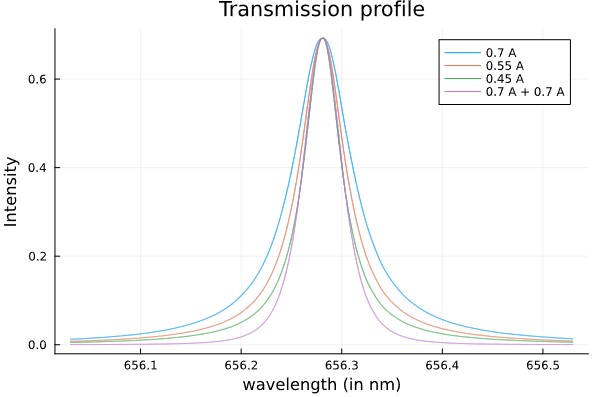
Using these transmission profiles, the solar spectrum transmitted by
the filter can be calculated (Transmitted spectrum = Transmission
Profile x Solar Spectrum):
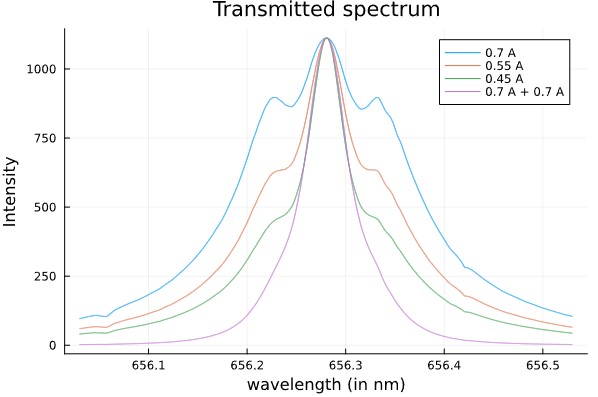
We can see that the single stack etalons transmit a significant part of
energy outside Ha, while the "off-band" energy is much lower with the
double-stack combination:

........................................................................................................................................................................................................................................................................................................................................................................................................................................................................................
Ha selectivity in collimated beam : comparison of the Heliostar 76 mm (single-stack) with the double-stack Lunt
The FWHM of the Heliostar 76 mm was measured at 0.25 A, while the FWHM of the Lunt 40 was measured at 0.65 A.
Therefore, it is interesting to compare the selectivity of the Heliostar and the double-stack Lunt 40.
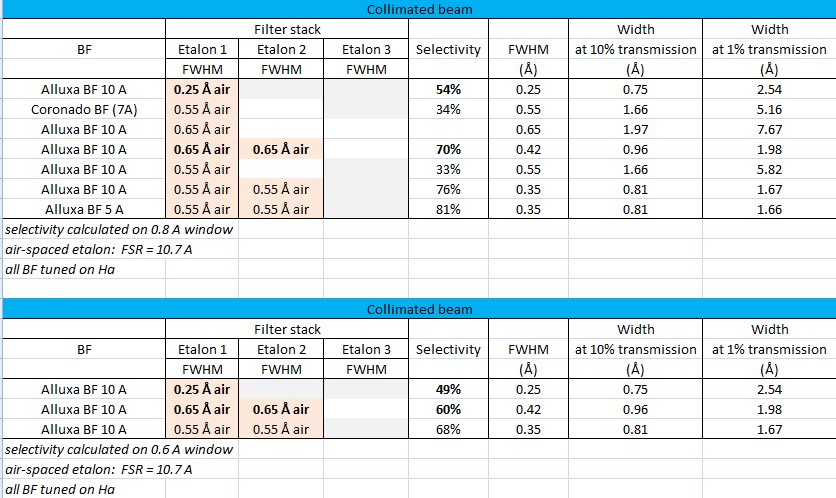
We can see that, despite its much lower FWHM, the Heliostar's
selectivity is significantly lower than that of the double-stack Lunt40
(54% versus 70%, calculated with a 0.8 A box defining what interval of
wavelengths "on-band").
To understand this, we can have a look at the transmission curves:
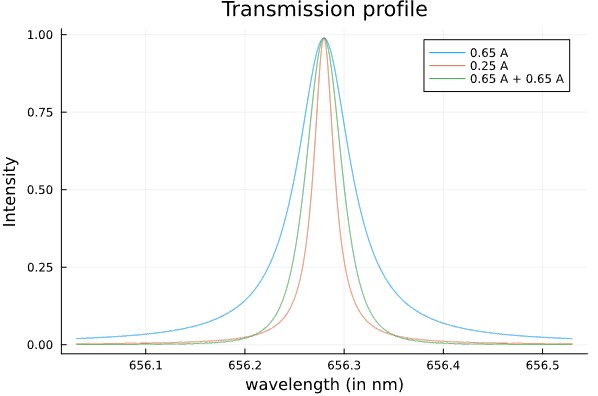
We can see that the 0.25 A etalon has a narrower transmission
profile across most of the curve, while the wings of transmission are
lower for the 0.5 A + 0.5 A combination.
Now, let's compare the solar spectrum transmitted by these configurations:
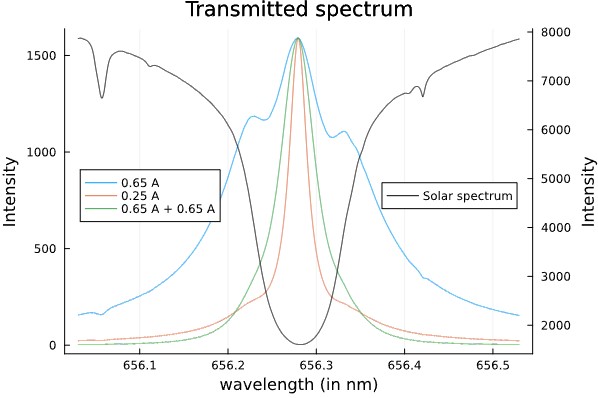
The comparison is made easier when the 0.8 A window defining the "Ha band" is displayed (in dash line)::
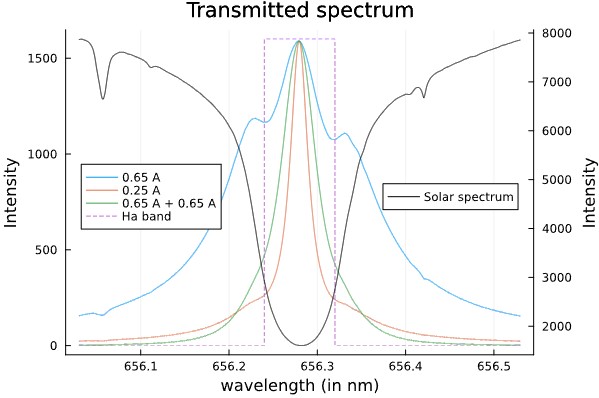
The relative energy
transmitted by the single-stack 0.25 A etalon outside the "Ha band"
(0.8A window centered on Ha) is larger than the one transmittted
by the double-stack 0.5 A + 0.5 A.
NB : this is true even if we consider windows of 0.4 A or 0.6 A (instead of 0.8 A) to define the "Ha band".
....................................................................................................................................................................................................................................................................................................................................................................................................................................................................................
Comparison of selectivity between a SHG and various etalon combinations
It is assumed that the profile of the SGH is Gaussian with a FWHM equal to 0.3 A.
In order to discriminate between very selective combinations, the box
size used to defined whatr is on Ha, and what is not on Ha, is taken
equal to 0.3 A.
The following figure compares:
- the solar spectrum transmitted by single-stack, double-stack,
triple-stack, quadruple-stack combination of 0.7 A air-spaced etalon(s),
- the solar spectrum transmitted by a SHG having a spectral resolution of 0.3 A and a gaussian profile,
- the box of 0.3 A defining what is consifered to be "on Ha)".

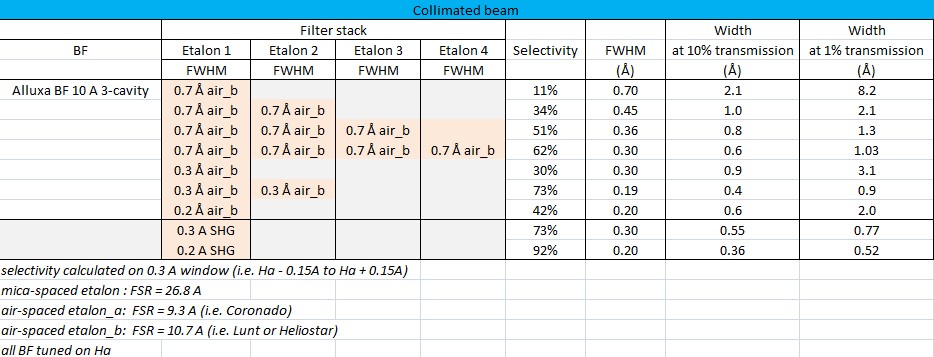
We can see that the selectivity of an SHG having a spectral resolution
of 0.3 A is a better than the selectivity of a quadruple-stack 0.7 A
air-spaced etalon combinaison, and similar to an hypothetical
double-stack 0.3 A air-spaced etalon combinaison.
We can also see that the increase of selectivity reduces when the number of stacked etalons increases.
Ha selectivity of various filter stacks in telecentric beam
In the following simulations, it is considered that all etalons are
finely tuned on Ha whatever the f-ratio (by heat control for mica-spaced
etalons, mechanical compression or pressure tuner for air-spaced
etalons).
Unless otherwise mentionned, etalons are mica-spaced.

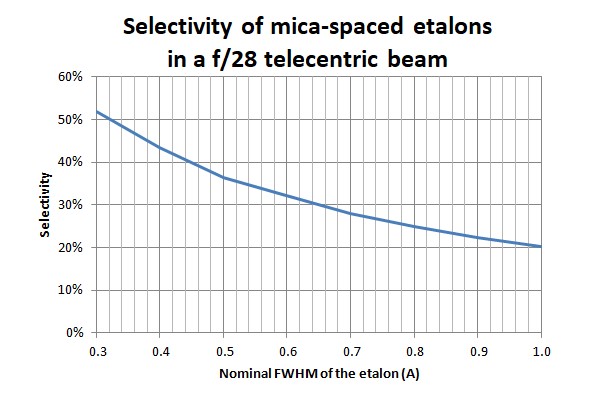
Some imaging tests
FP-contrast-2.htm
Example of transmission profiles for double-stack combination (mica-spaced etalons)
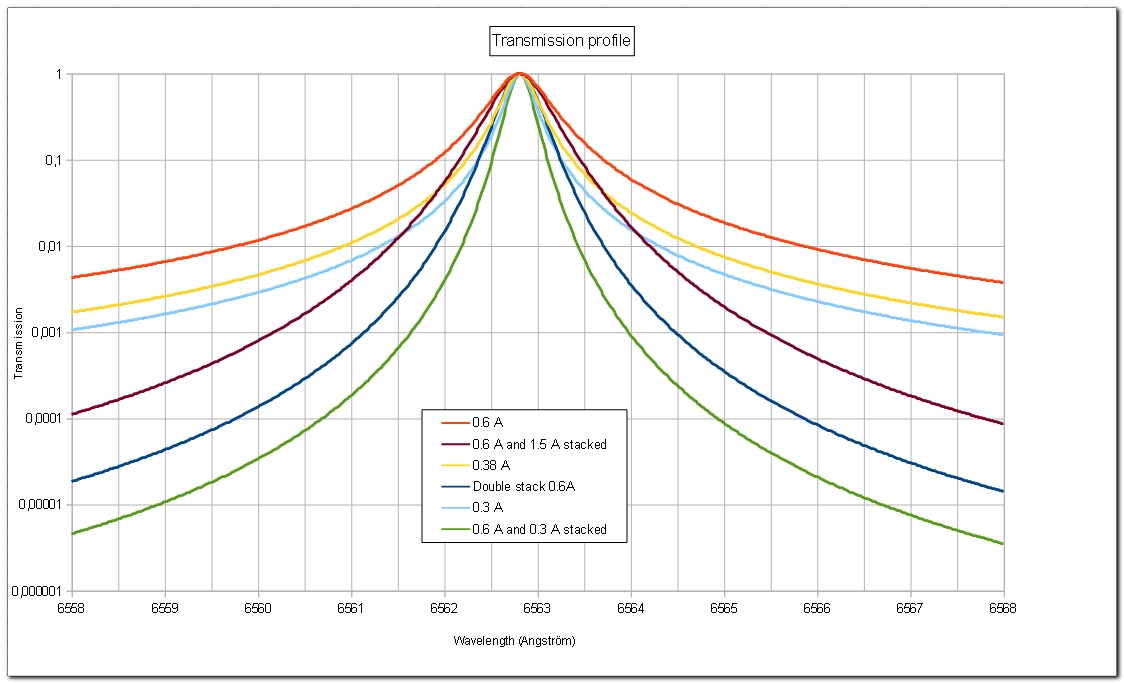
Conclusions on the contrast of filter stacked combinations
1) The FWHM is not the relevant indicator to assess the Ha selectivity of etalons (single or double stack).
2) The width at 10% or 1% peak transmission is a more relevant
indicator of the selectvity of a combination (i.e. of the ratio between the light
transmitted by the filter from the chromosphere to the total
transmitted light). It is a good indicator
for comparing and ranking single stack and multiple stack combinations.
















